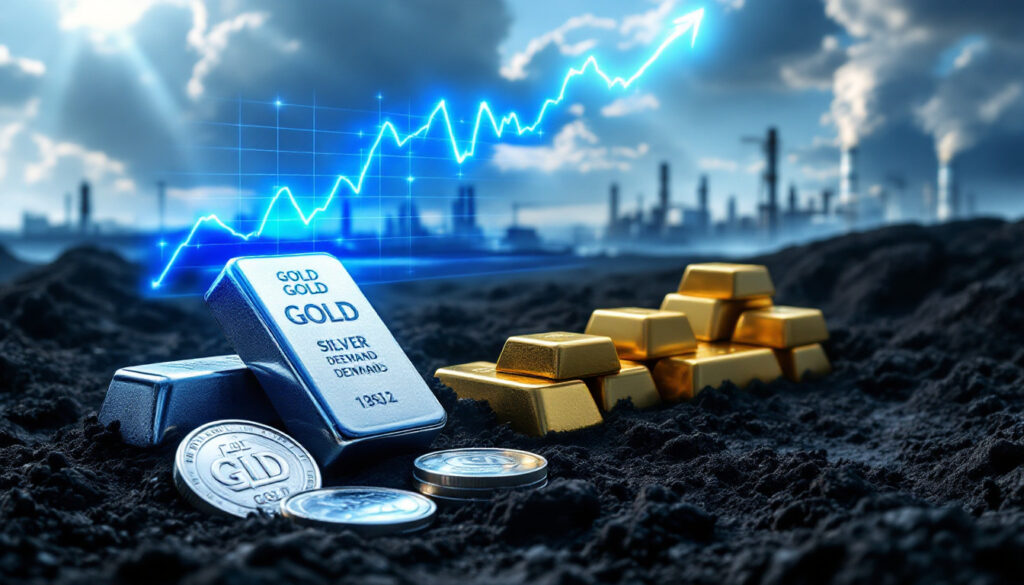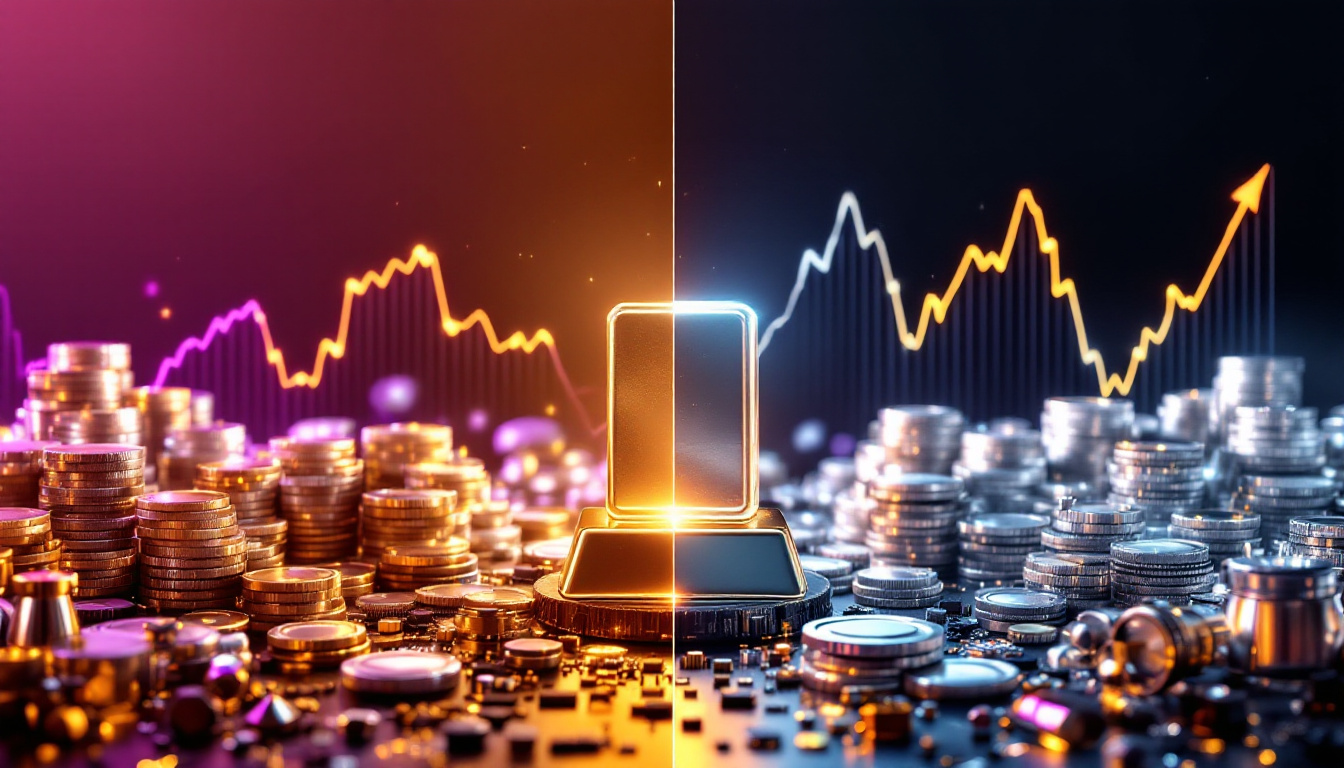Silver Supply Deficit: Market Dynamics and Investment Implications
The global silver market is navigating its fifth consecutive annual supply deficit, with the Silver Institute's 2025 survey projecting a shortfall of 117 million ounces. Despite a 1.5% increase in mining output, total supply remains insufficient to meet demand, which stands at 1.148 billion ounces—a slight decline from previous years. Industrial applications, particularly in automotive and electronics sectors, continue to anchor demand at 677.4 million ounces, offsetting a rare dip in solar photovoltaic consumption. Meanwhile, investor interest is rebounding, with physical bar and coin demand anticipated to rise by 7% to 204 million ounces, signaling renewed confidence in silver's dual role as a monetary and industrial asset. This report examines the structural drivers of the deficit, comparative performance against gold, and the interplay of economic conditions shaping silver's trajectory.
What Is Causing the Silver Supply Deficit?
The Fifth Consecutive Annual Deficit
The Silver Institute's 2025 survey highlights a persistent imbalance, marking the fifth straight year of supply shortfalls. The current deficit of 117 million ounces represents the narrowest gap in four years, yet underscores systemic challenges in aligning production with consumption. Total silver demand has dipped marginally to 1.148 billion ounces, while supply growth—driven primarily by mining—remains subdued at 1.5% annually. Philip Newman, Managing Director of Metals Focus, notes that "the market is nowhere near close to rebalancing itself," suggesting structural constraints rather than cyclical factors underpin the silver supply deficit.
Industrial Demand Fundamentals
Industrial consumption remains resilient at 677.4 million ounces, with electrical and electronics applications projected to grow by 1% in 2025. Automotive demand, fueled by vehicle electrification and higher semiconductor content per unit, now accounts for 62 million ounces annually—a 15% increase since 2021. Power grid modernization initiatives in the U.S. and EU28 nations are driving additional demand for silver-coated conductors, offsetting a 3% contraction in solar panel usage—the first decline in a decade. This sectoral shift reflects oversupply in photovoltaic manufacturing and improved thrifting techniques reducing silver loadings per cell.
Mining Production Trends
Global mine output has risen by 1.5%, led by expansions in Mexico and Kazakhstan, yet remains insufficient to close the deficit. Secondary supply from recycling has stagnated at 180 million ounces amid logistical challenges in recovering silver from end-of-life electronics. Newman emphasizes that even with projected production increases, "there's a few years left of deficit" due to lead times for new mining projects and declining ore grades at mature operations. Investors looking for exposure to this sector may consider investing in mining stocks to capitalize on these long-term trends.
How Does Silver Compare to Gold in Current Markets?
Gold-to-Silver Ratio Analysis
The gold-to-silver ratio remains elevated at 100:1—nearly double the 55-year average of 60:1—signaling silver's relative undervaluation. This disparity persists despite silver's 21% price appreciation in 2024, outpacing gold's 14% gain. Historical analysis shows the ratio typically contracts during inflationary periods, suggesting potential upside for silver if macroeconomic conditions align. For a more detailed examination of precious metals performance, the latest gold and silver trends 2024 provide valuable context.
Price Performance Metrics
Silver has established a consolidated support floor between $26.50 and $28.50 per ounce—a 30% increase from pre-pandemic levels. Technical analysts identify $40/oz as a plausible medium-term target should manufacturing PMIs stabilize above 50 and central banks maintain accommodative policies. However, the metal remains sensitive to derivatives market sentiment, with COMEX net long positions 22% below their 2023 peak.
What Drives Silver Investment Demand?
Current Investment Trends
Metals Focus projects a 14% annual increase in institutional silver exposure, equivalent to 70 metric tons. Retail investment is rebounding sharply in Europe, with German bar and coin purchases recovering to 85% of 2022 levels after two years of decline. ETF inflows totaled $1.2 billion in Q1 2025, reversing the $800 million outflow recorded in 2024. Understanding the distinction between investing vs. speculating is crucial when approaching the silver market.
Investment Appeal Factors
Silver's investment thesis hinges on three pillars:
-
Monetary Hedge: With a 180-day correlation of 0.87 to gold, silver retains safe-haven attributes while offering higher beta exposure.
-
Industrial Floor: 58% of annual demand stems from industrial uses, providing fundamental support absent in purely monetary metals.
-
Supply Constraints: The five-year cumulative deficit of 600 million ounces represents 55% of annual mine production, creating latent upward price pressure.
How Might Economic Conditions Impact Silver Prices?
Recession Risk Assessment
A hypothetical global recession could reduce industrial silver demand by 12-15% based on 2008-2009 analogs. However, Newman argues that "silver's diversity across 5,000 industrial applications provides recession resilience"—a view supported by the metal's 8% price increase during the 2023 manufacturing slowdown. Critical sectors like medical equipment (4% of demand) and nuclear reactor components (2%) exhibit low cyclicality, buffering against broader economic contractions.
Mitigating Factors for Downside Risk
Energy transition investments remain insulated from fiscal tightening, with the International Energy Agency projecting $1.7 trillion in annual clean energy spending through 2030. Silver-intensive technologies—including 5G infrastructure and AI data centers—are forecast to consume 90 million ounces annually by 2027, doubling 2021 levels. These structural demand drivers complement ongoing monetary investment, creating a balanced risk-reward profile. Looking forward, gold and silver 2025 trends suggest continued strength in this sector.
What Makes Silver's Market Dynamics Unique?
Physical vs. Paper Market Dynamics
The silver market exhibits a pronounced bifurcation between physical and paper trading. While London Bullion Market Association (LBMA) clearing volumes average 250 million ounces daily—a 40:1 ratio to annual mine production—physical deliveries rarely exceed 5% of contracts. This derivatives dominance amplifies price volatility, with the 30-day historical volatility reading of 32% eclipsing gold's 18%. Increasingly, systematic investing trends are being applied to navigate these complex market conditions.
Supply Deficit Interpretations
Analyst consensus on deficit measurements varies by ±20%, reflecting discrepancies in tracking artisanal mining and unreported stockpile drawdowns. Even conservative estimates acknowledge above-ground inventories have dwindled to 1.2 billion ounces—a 15-year low. Newman's projection of sustained deficits through 2027 suggests tightening fundamentals will ultimately override paper market distortions.
FAQs About the Silver Supply Deficit
How long has silver been in a supply deficit?
The Silver Institute confirms five consecutive annual deficits since 2021, with cumulative shortfalls exceeding 600 million ounces.
What industries drive silver demand?
Electronics (35%), automotive (12%), and solar (10%) lead industrial consumption, while jewelry and silverware account for 25%.
Will the silver supply deficit continue?
Metals Focus anticipates deficits persisting through 2027, constrained by 3-5 year lead times for new mining projects.
How does economic recession impact silver prices?
Historical analysis shows silver declines 22% on average during recession years, versus gold's 3% drop, though structural demand shifts may mitigate future downside.
What is the current gold-to-silver ratio?
The ratio stands at 100:1 as of April 2025, compared to a 50-year average of 60:1.
This comprehensive analysis underscores silver's complex interplay of industrial, monetary, and macroeconomic forces. While paper market volatility persists, the metal's expanding technological applications and constrained supply pipeline suggest sustained upward price pressure over the medium term. Investors are advised to monitor manufacturing PMIs, clean energy policy developments, and COMEX inventory trends when positioning in this bifurcated market.
Looking to Profit from the Next Major Mineral Discovery?
Stay ahead of the market with Discovery Alert's proprietary Discovery IQ model, which delivers real-time notifications when significant ASX mineral discoveries are announced. Understand why historic discoveries can generate substantial returns by visiting the Discovery Alert's dedicated discoveries page.




